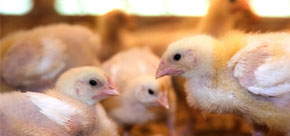Turkeys Standards
HOUSING, SHELTER AND HANDLING FACILITIES Version 5.1 (modified)
Click to view
Key – Those standards which have greater significance (all other standards are normal)
Recommendation – Those which do not affect certification
New – A completely new standard which the member must now adhere to
Revised – A standard that has changed and requires the member to take some different or additional action to before
Upgraded – The standard has been upgraded to a Key standard or from a Recommendation to a full standard
Appendix – Referenced in ‘How you will be measured’. Indicates that additional information is provided in the Appendices, which are available at the end of each section.
TR.HF.1 Key
Housing/hatchery must be constructed and maintained to provide a safe and secure environment for birds/poults
How you will be measured
TR.HF.1.a
TR.HF.1.b
TR.HF.1.c
TR.HF.1.d
TR.HF.1.1
The sound level in housing must be minimised
How you will be measured
TR.HF.1.1.a
TR.HF.2
Housing/hatchery must be appropriately and effectively ventilated
How you will be measured
TR.HF.2.a
TR.HF.2.b
Ventilation plan
TR.HF.2.1
Temperature records must be kept
How you will be measured
TR.HF.2.1.a
Temperature records
TR.HF.2.2
A written policy must be in place outlining recognition of and procedures to be followed in the event of heat or cold stress occurring
How you will be measured
TR.HF.2.2.a
TR.HF.2.2.b
Heat and cold stress policy
TR.HF.3
Floors must be constructed and maintained in a manner that minimises the risk of injury
How you will be measured
TR.HF.3.a
TR.HF.3.b
TR.HF.4 Key
Conditions within the housing must be maintained in a manner that ensures birds are able to keep clean
How you will be measured
TR.HF.4.a
TR.HF.4.c
TR.HF.4.d
TR.HF.4.f
- Cleaning and disinfection policy
- Cleaning records
- Environmental bacteria test records
TR.HF.4.1
Surfaces within housing/hatchery must be in good condition and must be able to be cleaned and disinfected
TR.HF.4.2
Flocks are provided with clean, fresh bedding to a minimum depth of 2cm
How you will be measured
TR.HF.4.2.a
TR.HF.4.2.b
TR.HF.4.3
Bedding must remain in a dry, friable condition
How you will be measured
TR.HF.4.3.a
TR.HF.4.4
Bedding stored in the open is stored on pallets and is covered
How you will be measured
TR.HF.4.4.a
TR.HF.4.4.b
TR.HF.4.4.c
TR.HF.4.5
Bedding is traceable
Record of origin of bedding
TR.HF.4.9
It is recommended that bales are stored in buildings which do not allow for the ingress of wild birds or rodents
TR.HF.5
Housing/hatchery must be lit to allow normal behaviours, rest and effective inspection of birds/poults
How you will be measured
TR.HF.5.a
TR.HF.5.b
TR.HF.5.c
- Lighting pattern records
- Lux reduction review
- Light level records
TR.HF.5.1
Lighting follows a 24 hour rhythm
How you will be measured
TR.HF.5.1.a
TR.HF.5.1.b
TR.HF.6 Key
Housing/poult areas must be of sufficient size
How you will be measured
TR.HF.6.a
- Poult placement records
- Flock weight records
TR.HF.6.1
Houses must have plates which highlight important information
How you will be measured
TR.HF.6.1.a
TR.HF.7
Housing areas must provide for the specific needs of young birds
How you will be measured
TR.HF.7.a
TR.HF.8
Automatic equipment is inspected once a day
How you will be measured
TR.HF.8.a
TR.HF.8.b
- Equipment inspection records
- Maintenance schedules
- Calibration schedules
TR.HF.8.1
An alternative power supply must be available which is capable of supplying all essential electrical systems within the poultry houses/hatchery
How you will be measured
TR.HF.8.1.a
TR.HF.8.1.b
Generator test record
TR.HF.8.2
An alarm system must be in place which alerts stockmen to ventilation equipment failure
How you will be measured
TR.HF.8.2.a
TR.HF.8.2.b
TR.HF.8.2.c
TR.HF.8.2.d
- Alarm system checks
- Alarm test records
TR.HF.9
Fire prevention measures must be taken
How you will be measured
TR.HF.9.a
TR.HF.9.b
TR.HF.9.c
TR.HF.9.d
TR.HF.9.e
TR.HF.9.f
TR.HF.9.g
TR.HF.9.h
- Government guidance on farm fires and protecting farm animal welfare: https://www.gov.uk/government/publications/farm-fires-protecting-farm-animal-welfare
- For additional guidance on animal welfare in severe weather visit: www.gov.uk/guidance/keeping-farm-animals-and-horses-in-extreme-weather
- Further information on heat stress is provided in the Defra guidance document `Heat Stress in Poultry: Solving the Problem’: https://assets.publishing.service.gov.uk/government/uploads/system/uploads/attachment_data/file/69373/pb10543-heat-stress-050330.pdf
